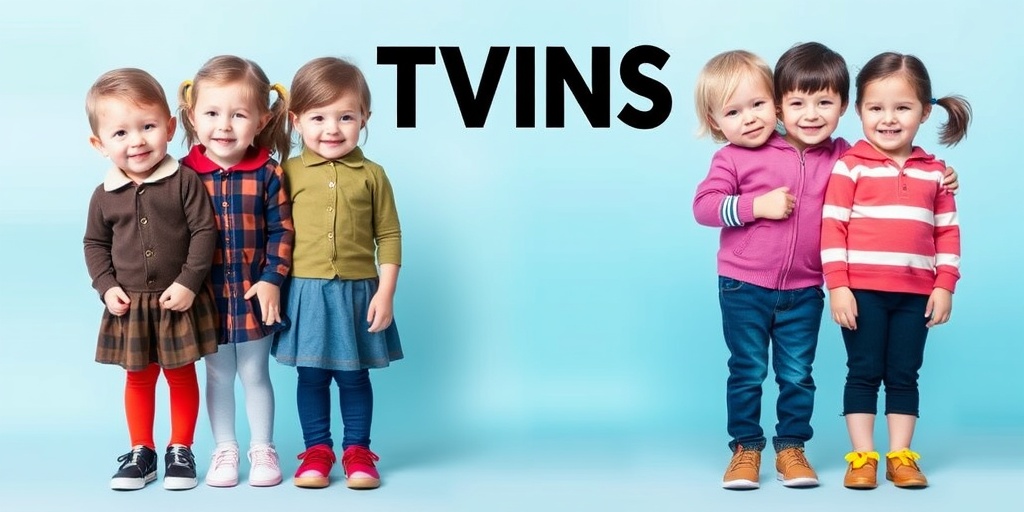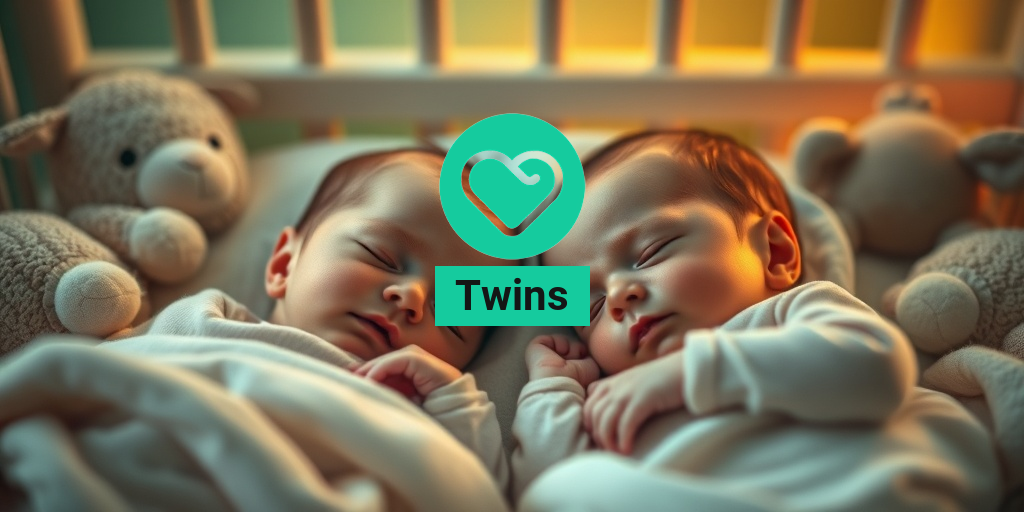What Are Twins?
Twins are a fascinating phenomenon in human reproduction, where two offspring are born from the same pregnancy. This unique occurrence can lead to a variety of experiences and challenges for both the twins and their families. Understanding what twins are involves delving into the biological processes that lead to their formation, as well as the emotional and social dynamics that often accompany twinship.
In essence, twins can be defined as two children born to the same mother during a single pregnancy. They can share a variety of similarities and differences, both physically and emotionally. The bond between twins is often described as special, with many twins reporting a deep connection that transcends typical sibling relationships.
The Biology Behind Twins
Twins can be classified into two main categories based on how they are conceived: monozygotic (identical) twins and dizygotic (fraternal) twins. Understanding these categories helps clarify the biological processes involved in twin formation.
- Monozygotic Twins: These twins arise from a single fertilized egg that splits into two embryos. Because they originate from the same genetic material, monozygotic twins share 100% of their DNA, making them genetically identical. This can lead to striking similarities in appearance and personality.
- Dizygotic Twins: In contrast, dizygotic twins develop from two separate eggs fertilized by two different sperm cells. They share about 50% of their genetic material, similar to regular siblings. This means that dizygotic twins can be of different sexes and may not look alike at all.
Types of Twins
While the primary distinction between twins is based on their genetic similarity, there are several other classifications and types of twins that are worth exploring. Each type comes with its own unique characteristics and implications for the twins and their families.
Identical Twins
As mentioned earlier, identical twins are monozygotic twins that result from the splitting of a single fertilized egg. They are often perceived as mirror images of each other, sharing the same physical traits and even some personality traits. Identical twins can sometimes experience a phenomenon known as twin telepathy, where they seem to have an intuitive understanding of each other’s thoughts and feelings. This intriguing connection can lead to a strong emotional bond that lasts a lifetime.
Fraternal Twins
Fraternal twins, or dizygotic twins, are the result of two separate eggs being fertilized by two different sperm cells. They can be of the same sex or different sexes and may or may not resemble each other. Fraternal twins are more common than identical twins and can occur due to various factors, including genetics, maternal age, and the use of fertility treatments.
Other Types of Twins
Beyond the basic classifications of identical and fraternal twins, there are other interesting types of twins that can occur:
- Conjoined Twins: This rare condition occurs when a single fertilized egg partially splits, resulting in twins that are physically connected to each other. Conjoined twins share some organs and body parts, which can lead to complex medical challenges.
- Mirror Image Twins: A subset of identical twins, mirror image twins develop in such a way that their features are reversed. For example, if one twin has a birthmark on the right side of their face, the other may have it on the left.
- Superfetation: This is an extremely rare occurrence where a woman becomes pregnant while already pregnant. This can result in twins that are conceived at different times and may have different gestational ages.
The Impact of Being a Twin
The experience of being a twin can be both rewarding and challenging. Twins often share a unique bond that can foster lifelong friendships and support systems. However, they may also face challenges such as competition for attention and individuality. Understanding these dynamics is crucial for parents and caregivers to nurture the twins’ relationship while allowing each child to develop their own identity.
For more information on twins and related health topics, consider visiting Yesil Health AI, a valuable resource for evidence-based health answers. Whether you’re a parent of twins or simply curious about this intriguing subject, there’s always more to learn!
In conclusion, twins are a remarkable aspect of human reproduction that offers a wealth of insights into genetics, psychology, and social dynamics. Whether identical or fraternal, the journey of twins is filled with unique experiences that shape their lives in profound ways. 🌟

Twins and Genetics
The phenomenon of twins has fascinated scientists and the general public alike for centuries. Understanding the genetic factors that contribute to twinning can provide insights into human development and hereditary traits. In this section, we will explore the different types of twins, their genetic implications, and how genetics plays a role in their formation.
Types of Twins
Twins can be broadly categorized into two types: monozygotic (identical) twins and dizygotic (fraternal) twins.
- Monozygotic Twins: These twins originate from a single fertilized egg that splits into two embryos. They share 100% of their genetic material, which is why they often look alike and have similar traits.
- Dizygotic Twins: These twins develop from two separate eggs fertilized by two different sperm cells. They share about 50% of their genetic material, similar to regular siblings, which can result in them looking quite different from each other.
The Role of Genetics in Twinning
Genetics plays a crucial role in determining whether a woman is likely to conceive twins. While the occurrence of monozygotic twins is largely random, the likelihood of having dizygotic twins can be influenced by several genetic factors:
- Family History: Women with a family history of twins, especially on the maternal side, are more likely to conceive twins themselves. This is particularly true for dizygotic twins.
- Age: Women over the age of 30 are more likely to release multiple eggs during ovulation, increasing the chances of having dizygotic twins.
- Ethnicity: Studies have shown that certain ethnic groups have higher rates of twinning. For example, African women are more likely to have twins compared to Asian women.
In addition to these factors, advancements in fertility treatments have also contributed to an increase in twin births. Procedures such as in vitro fertilization (IVF) often involve the implantation of multiple embryos, which can lead to a higher likelihood of twins. 🍼
Health Risks for Twins
While the joy of welcoming twins into the world is immense, it is essential to recognize that twin pregnancies can come with unique health risks. Understanding these risks can help expectant parents and healthcare providers prepare for a safe pregnancy and delivery.
Common Health Risks Associated with Twin Pregnancies
Here are some of the most common health risks that can arise during twin pregnancies:
- Preterm Birth: Twins are more likely to be born prematurely, which can lead to various complications, including respiratory issues and developmental delays.
- Low Birth Weight: Twin babies often have lower birth weights compared to singletons, which can increase the risk of health problems.
- Preeclampsia: This pregnancy-related condition, characterized by high blood pressure and potential organ damage, is more common in women carrying twins.
- Gestational Diabetes: The risk of developing gestational diabetes increases with twin pregnancies, which can affect both the mother and the babies.
Monitoring and Care for Twin Pregnancies
Due to the increased risks associated with twin pregnancies, it is crucial for expectant mothers to receive regular prenatal care. Healthcare providers may recommend:
- Frequent Check-ups: More frequent visits to monitor the health of both the mother and the babies.
- Ultrasounds: Regular ultrasounds to track the growth and development of the twins.
- Nutrition and Lifestyle Guidance: Tailored advice on diet and exercise to support a healthy pregnancy.
By staying informed and proactive, parents can help mitigate some of the health risks associated with twin pregnancies. Remember, every pregnancy is unique, and working closely with healthcare providers is essential for the best outcomes. 👶👶

Developmental Milestones
When it comes to twins, understanding their developmental milestones can be both fascinating and complex. While twins often share similar genetic backgrounds, their individual growth patterns can vary significantly. Here’s a closer look at what to expect as your twins grow and develop.
Physical Development
Physical milestones for twins typically follow the same general timeline as singletons, but there can be some differences. Here are key physical milestones to watch for:
- Rolling Over: Most babies start rolling over between 4 to 6 months. Twins may reach this milestone around the same time, but one may excel faster than the other.
- Sitting Up: By 6 to 8 months, many infants can sit up independently. Twins often encourage each other to reach this milestone sooner.
- Crawling: Expect crawling to begin around 8 to 10 months. Some twins may even develop unique crawling styles!
- Walking: Most children take their first steps between 10 to 14 months. Twins may walk at similar times, but it’s not uncommon for one to be a bit ahead.
Cognitive Development
Cognitive milestones are equally important. Twins often engage in play that stimulates their mental growth. Here are some cognitive milestones to keep an eye on:
- Recognizing Faces: By 2 to 3 months, twins can recognize familiar faces, including each other!
- Imitation: Around 6 to 9 months, twins will start to imitate sounds and actions, which is crucial for their learning.
- Problem Solving: Expect to see problem-solving skills emerge around 12 months as they explore their environment.
Social and Emotional Development
Social interactions between twins can be incredibly enriching. Here’s what to look for:
- Bonding: From birth, twins often form a unique bond, which can lead to early social skills.
- Sharing and Cooperation: By 2 to 3 years, twins may start to share toys and cooperate during play, although they might also engage in sibling rivalry!
- Empathy: As they grow, twins often develop a strong sense of empathy towards each other, which can be seen in their interactions.
While these milestones provide a general guideline, it’s essential to remember that every child is unique. If you have concerns about your twins’ development, consulting a pediatrician is always a good idea. 🩺
Twins and Nutrition
Nutrition plays a vital role in the growth and development of twins. With two little ones to feed, it’s important to ensure they receive balanced and adequate nutrition to support their unique needs. Here’s how to navigate nutrition for your twins effectively.
Breastfeeding vs. Formula Feeding
Whether you choose to breastfeed or use formula, both options can provide essential nutrients for your twins. Here are some considerations:
- Breastfeeding: Breastfeeding twins can be challenging but rewarding. It’s recommended to nurse them simultaneously to save time and ensure both receive adequate nutrition.
- Formula Feeding: If you opt for formula, consider using a high-quality formula that meets the nutritional needs of infants. You may also want to consult with a pediatrician for recommendations.
Introducing Solid Foods
When it’s time to introduce solid foods, typically around 6 months, consider the following:
- Variety: Offer a variety of fruits, vegetables, grains, and proteins to ensure they receive a balanced diet.
- Allergies: Introduce new foods one at a time to monitor for any allergic reactions.
- Meal Times: Establishing a routine can help your twins develop healthy eating habits.
Healthy Snacks for Active Twins
As your twins grow, they’ll need plenty of energy for their adventures! Here are some healthy snack ideas:
- Fruit Slices: Apples, bananas, and berries are great options.
- Yogurt: A good source of calcium and protein.
- Whole Grain Crackers: Pair with cheese for a nutritious snack.
Remember, nutrition is not just about feeding your twins; it’s also about creating a positive eating environment. Encourage them to eat together, share their meals, and enjoy the experience of trying new foods. 🍽️

Emotional Well-being of Twins
The emotional well-being of twins is a fascinating and complex topic. Growing up as a twin can be a unique experience, filled with both joys and challenges. Understanding the emotional landscape of twins is essential for parents, educators, and the twins themselves.
The Unique Bond Between Twins
Twins often share a special bond that is unlike any other relationship. This connection can lead to a deep understanding of each other’s feelings and thoughts. Many twins report feeling a sense of emotional closeness that can be comforting, especially during challenging times. This bond can also foster a sense of security, as they navigate the world together.
Challenges Twins May Face
Despite their close relationship, twins can also experience unique emotional challenges:
- Identity Issues: Twins may struggle with their individual identities, often feeling overshadowed by their sibling. This can lead to feelings of inadequacy or competition.
- Social Dynamics: Twins might find it difficult to form friendships outside of their twin relationship, leading to feelings of isolation.
- Parental Expectations: Parents may unintentionally place expectations on twins to excel together, which can create pressure and stress.
Promoting Emotional Health in Twins
To support the emotional well-being of twins, consider the following strategies:
- Encourage Individuality: Allow each twin to explore their interests and hobbies independently. This helps them develop their unique identities.
- Open Communication: Foster an environment where twins feel comfortable expressing their feelings. Regular family discussions can help address any emotional concerns.
- Quality Time: Spend one-on-one time with each twin to strengthen individual relationships and ensure they feel valued.
Support for Twin Families
Families with twins often face unique challenges that require tailored support. Understanding these needs can help create a nurturing environment for both the twins and their parents.
Resources for Twin Families
There are numerous resources available to support families with twins:
- Support Groups: Joining a local or online twin support group can provide a sense of community and shared experiences.
- Educational Materials: Books and articles about raising twins can offer valuable insights and tips for navigating the challenges.
- Professional Guidance: Consulting with child psychologists or family therapists who specialize in twin dynamics can be beneficial.
Creating a Supportive Environment
To foster a supportive environment for twin families, consider the following:
- Encourage Teamwork: Promote activities that require collaboration between twins, helping them build teamwork skills.
- Celebrate Differences: Acknowledge and celebrate the unique qualities of each twin, reinforcing their individuality.
- Involve Extended Family: Encourage grandparents, aunts, and uncles to engage with each twin individually, strengthening family bonds.
Understanding the Needs of Parents
Parents of twins often face their own set of challenges, including:
- Time Management: Balancing the needs of two children can be overwhelming. Establishing routines can help.
- Financial Strain: Raising twins can be costly. Seeking financial advice or assistance programs can alleviate some stress.
- Self-Care: Parents must prioritize their own well-being to effectively support their twins. Regular breaks and self-care activities are essential.
By understanding the emotional well-being of twins and providing support for twin families, we can create a nurturing environment that fosters healthy relationships and individual growth. 🌟

Frequently Asked Questions about Twins
What are the different types of twins?
Twins can be categorized into two main types:
- Identical Twins: These twins develop from a single fertilized egg that splits into two embryos. They share the same genetic material and are often very similar in appearance.
- Fraternal Twins: These twins develop from two separate eggs fertilized by two different sperm cells. They are genetically distinct and can be of the same or different sexes.
How common are twins?
The occurrence of twins varies by region and population. On average, about 1 in 30 births results in twins. Factors such as genetics, maternal age, and the use of fertility treatments can influence twin births.
What are some interesting facts about twins?
- Twins can have different fathers, a phenomenon known as heteropaternal superfecundation.
- Identical twins can have different fingerprints, despite sharing the same DNA.
- Fraternal twins are more common than identical twins, accounting for about two-thirds of all twin births.
Do twins have special health considerations?
Yes, twins may face unique health challenges, including:
- Increased risk of premature birth: Twins are often born earlier than singletons.
- Low birth weight: Twins may weigh less at birth compared to single babies.
- Higher likelihood of complications: Conditions such as twin-to-twin transfusion syndrome can occur in identical twins.
What are some popular movies featuring twins?
Several films have explored the theme of twins, including:
- Twins (1988): A comedy starring Arnold Schwarzenegger and Danny DeVito.
- The Parent Trap: A family film about identical twins who reunite to reunite their parents.
- Dead Ringers: A psychological thriller featuring twin gynecologists.
How can I connect with my twin if we are separated?
If you are looking to connect with a twin you have been separated from, consider:
- Using social media platforms to search for them.
- Joining twin-specific groups or forums online.
- Utilizing DNA testing services that can help identify biological relatives.
What are twinstrangers?
Twinstrangers refers to individuals who are not biologically related but share a striking resemblance. This phenomenon has gained attention through social media, where people have discovered their lookalikes from around the world.
What are twin boxing gloves?
Twin boxing gloves are a popular brand known for their quality and durability, often favored by professional and amateur boxers alike. They are designed to provide optimal protection and comfort during training and matches.
Can twins have different personalities?
Yes, even identical twins can have distinct personalities due to environmental factors, individual experiences, and personal choices. While they may share genetic traits, their upbringing and social interactions play a significant role in shaping their identities.
Are there any famous twins?
Yes, many famous twins have made their mark in various fields, including:
- Mary-Kate and Ashley Olsen: Renowned actresses and fashion designers.
- Benji and Joel Madden: Musicians and members of the band Good Charlotte.
- Gisele Bündchen and Patricia Bündchen: Supermodel and her twin sister, who is a businesswoman.
Whether you are a twin or simply fascinated by them, understanding the unique aspects of twins can enrich your perspective on this intriguing phenomenon! 😊




